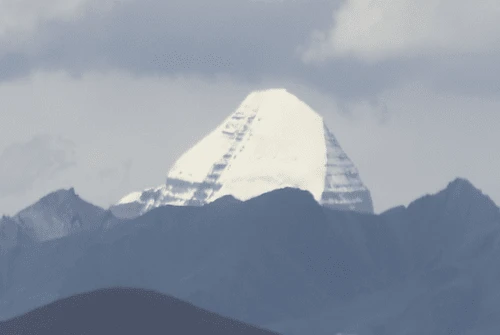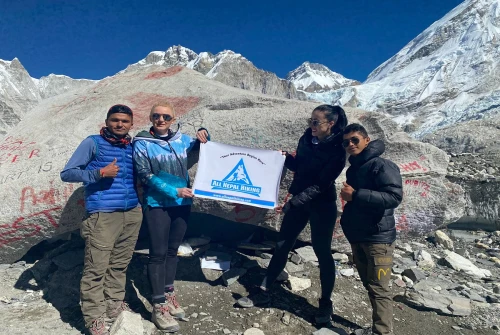Dreaming of your first Himalayan summit? Island Peak (Imja Tse), rising to 6,189 meters (20,305 feet) in Nepal’s iconic Everest region, offers the perfect blend of trekking and mountaineering, making it a popular choice for fit adventurers, experienced trekkers, and aspiring climbers.
While it’s considered suitable for beginners with some mountain experience, reaching the summit requires dedicated physical training, altitude preparation, and basic technical skills.
At All Nepal Hiking, we’ve successfully guided hundreds of climbers to the top of Island Peak. Based on our expertise, we know that success comes down to smart preparation and a well-structured training plan.
In this guide, you'll discover how to build mountain-specific fitness, adapt effectively to high altitude, develop basic climbing techniques, and prepare the right gear and mindset for summit day. Whether you're stepping into mountaineering for the first time or aiming to improve your performance, this is your complete training roadmap for a safe and successful Island Peak expedition.
Understanding the Island Peak Challenge
Island Peak (Imja Tse) is officially categorized as a trekking peak in Nepal, but it presents a serious challenge even for experienced trekkers and climbers. The expedition combines long trekking days at high altitude with technical climbing elements, making it a true test of fitness, skill, and altitude acclimatization. Located in the Everest region, this peak requires climbers to traverse glaciers, negotiate ladders and fixed ropes, and scale steep ice walls.
The summit climb of Island Peak involves a strenuous ascent up a snow and ice headwall followed by a narrow and exposed summit ridge, demanding careful navigation and mountaineering expertise. Some of the most significant challenges include:
Severe altitude exposure above 5,000 meters increases the risk of altitude sickness.
A demanding summit push lasting 10 to 14 hours, requiring excellent endurance and mental strength.
The need to use mountaineering gear such as crampons, ice axes, harnesses, and fixed ropes in potentially extreme weather conditions.
The constant risk of Acute Mountain Sickness (AMS) due to rapid altitude gain.
Technical skills for safe crampon and rope work on exposed icy and snowy terrain.
These factors highlight why training for Island Peak Climbing must be comprehensive, focusing on improving cardiovascular endurance, building muscular strength, mastering basic mountaineering techniques, and developing altitude tolerance to prevent AMS. Proper preparation ensures climbers can safely and confidently tackle this challenging Himalayan trekking peak.
When Should You Start Training for Island Peak?
To successfully summit Island Peak, it’s crucial to begin your training at least 3 to 6 months before your expedition. The ideal start time depends largely on your current fitness and trekking experience. If you are already hiking regularly and maintain good physical condition, a focused 3-month training plan may be sufficient to prepare you for the challenge. However, if you’re new to trekking or have a lower fitness level, it’s best to allow 6 months or more to build the necessary endurance and strength.
Your training program should follow a gradual progression, steadily increasing in intensity and specificity. Key goals during this period include developing cardiovascular endurance for long trekking days, building muscle strength to carry heavy loads and climb steep terrain, enhancing core stability for balance and injury prevention, improving your confidence with rope and crampon techniques, and boosting your body’s altitude resilience to minimize the risk of Acute Mountain Sickness (AMS).
At All Nepal Hiking, we offer personalized training strategies tailored to your current fitness, experience level, and expedition timeline to maximize your chances of a safe and successful Island Peak climbing experience.
How to Prepare for Island Peak Climbing
Proper preparation is the foundation of a successful Island Peak climbing adventure. Even before you set foot in Nepal, the steps you take in planning, training, and organizing your gear will greatly influence your chances of reaching the summit.
From physical fitness and altitude readiness to understanding the route and packing the right equipment, Island Peak preparation begins long before the actual expedition. The right approach ensures not just a successful climb but a safe and memorable journey in the heart of the Himalayas. To help you get started, here are the essential preparations you should focus on before and during your Island Peak climb.
Cardiovascular Training: Building Stamina for Long Climbs
Cardiovascular endurance is the foundation of fitness needed for the Island Peak expedition. You will be hiking for 6 to 8 hours daily, often on steep inclines and rocky trails, where high-altitude trekking demands your cardiovascular system to work harder due to reduced oxygen levels. Recommended cardio exercises include hiking with a backpack (10–15 kg), which closely mimics actual trekking conditions and builds muscular endurance.
Running or trail running improves heart and lung function and boosts stamina. Stair climbing or incline treadmill workouts specifically target muscles used during steep ascents. Cycling and swimming offer excellent low-impact cardio options to develop aerobic capacity. Start with 30 to 45-minute sessions, 4 to 5 days per week, gradually increasing to 60 to 90-minute sessions with long weekend hikes to simulate trekking conditions.
Strength Training: Preparing Your Body for Heavy Loads and Steep Terrain
Strength training is essential for carrying heavy trekking gear, using mountaineering equipment, and hiking on steep mountain slopes. It helps build strong legs, a stable core, and upper body endurance, preventing fatigue and injuries during your Island Peak climb. Focus on compound exercises like squats, lunges, and deadlifts to strengthen your quadriceps, glutes, and hamstrings. Step-ups with weights simulate uphill movement while carrying a pack. Core exercises such as planks and Russian twists improve balance and stability. Push-ups, pull-ups, and shoulder presses develop upper body strength crucial for handling ropes and ice axes. Train 2 to 3 times per week, alternating between lower and upper body workouts, and allow rest days for muscle recovery.
Technical Skills: Rope Work, Crampons, and Ice Axe Practice
The final summit section of Island Peak requires basic mountaineering skills, including the use of a jumar (ascender) to climb fixed ropes and rappelling on descent. Mastering these skills before the expedition is critical for safety. Practice walking in crampons on snow and ice, using an ice axe for balance and self-arrest, ascending with a jumar, rappelling with a figure-8 device, and tying essential knots like the figure-8, clove hitch, and prusik. Consider enrolling in a mountaineering course or training at an indoor climbing gym. For acclimatization and technical preparation, climbing peaks like Yala Peak or Lobuche East in Nepal is highly recommended. At All Nepal Hiking, we offer pre-climb technical refresher training as part of our guided Island Peak expeditions.
Acclimatization and Altitude Training
Altitude sickness or Acute Mountain Sickness (AMS) is a serious risk on high-altitude treks like Island Peak. Even well-trained climbers can be affected. Follow a gradual itinerary for natural acclimatization, often similar to the Everest Base Camp trek, with rest days at Namche Bazaar (3,440m) and Dingboche (4,410m). Use the “climb high, sleep low” strategy by hiking to higher altitudes during the day but returning to lower elevations to sleep. Stay well-hydrated by drinking 3 to 4 liters of water daily and consume high-carbohydrate meals that are easier to digest at altitude. Avoid alcohol and smoking as they increase AMS risk. Consult your doctor about using Diamox (Acetazolamide) for AMS prevention. If possible, enhance your training with altitude simulation masks or spend time training at moderate elevations to boost your altitude adaptation before the expedition.
Gear Familiarity and Packing Practice
Before your Island Peak expedition, it’s essential to get familiar with all your mountaineering gear. Spend time practicing with your equipment so you feel confident using everything on the mountain. For example, wear your crampons along with your boots and gloves to get used to walking safely on snow and ice. Practice setting up your climbing harness, using the jumar (ascender), and managing the rappel system several times to build your rope-handling skills.
Make sure your backpack fits properly and practice carrying it loaded with the typical weight you’ll carry during the trek. If possible, sleep in your sleeping bag and even your tent beforehand to test how warm and comfortable you’ll be in cold, high-altitude conditions.
Being confident and comfortable with your gear will help reduce transition times during the climb and minimize mistakes when the pressure is on. At All Nepal Hiking, we include hands-on gear orientation in our pre-departure briefings to ensure our climbers feel fully prepared and confident for their Island Peak climb.
Nutrition and Recovery
When you're training for something as demanding as Island Peak, what you eat and how you recover are just as important as your workouts. Without the right fuel and proper rest, your progress can slow down, and your body won’t perform at its best—especially at high altitudes.
Start by focusing on balanced nutrition. Fill your meals with complex carbohydrates for long-lasting energy, lean proteins to support muscle repair, and healthy fats to keep you satisfied and fueled. Drink plenty of water throughout the day, especially after intense cardio or strength sessions. Don’t skip your pre- and post-workout meals—they’re key for endurance and recovery. Try to avoid heavily processed foods and sugar-loaded snacks, which can leave you feeling sluggish.
Recovery matters just as much. Aim to get 7 to 9 hours of quality sleep each night—your body does most of its rebuilding while you rest. After each training session, take time to stretch and improve your flexibility. Use foam rollers or try an Epsom salt bath to ease sore muscles. And be sure to take at least one full rest day every week to let your body reset and avoid overtraining.
At All Nepal Hiking, we encourage climbers to treat rest and nutrition as essential parts of their Island Peak training plan, not as optional add-ons. A strong, well-fueled, and well-rested body is far more likely to reach the summit safely and successfully.
Mental Preparation: Building Resilience
Climbing Island Peak isn’t just about physical fitness—it’s a serious mental challenge too. Summit days can be long, dark, cold, and incredibly demanding. When your body is tired and the altitude kicks in, it’s often mental strength that decides whether you reach the top or turn back.
Building resilience takes practice, just like training your body. Start by incorporating cold exposure into your routine—take cold showers or go on winter hikes to get used to discomfort. It helps condition your mind to stay calm and focused under tough conditions.
Visualization is another powerful tool. Regularly picture yourself on the mountain: feeling the cold, handling the ropes, pushing through exhaustion, and finally reaching the summit. Visualizing both the struggles and the success helps you stay mentally prepared when things get real.
Try hiking solo in rough weather or unfamiliar terrain. It builds self-reliance and confidence, which are key when you're facing unpredictable mountain environments. And most importantly—don’t always choose the easy route. Train in ways that challenge you mentally and physically. Embrace the discomfort. That’s where real resilience is built.
At All Nepal Hiking, we know that climbing Island Peak is as much a mental journey as a physical one. We encourage our clients to prepare both body and mind to face the mountain with confidence and clarity.
Final Thoughts: Your Summit Begins at Home
Reaching the summit of Island Peak is an incredible achievement but the journey truly begins long before you set foot in Nepal. Success on the mountain depends on how well you prepare at home. With a solid combination of cardiovascular endurance, strength training, technical mountaineering skills, and a clear understanding of altitude acclimatization, you can significantly improve your chances of summiting safely and confidently.
But training for Island Peak is more than just physical; it's a test of self-discipline, focus, and mental resilience. Start your preparation early, stay consistent, and most importantly, respect the mountain every step of the way.
When summit day arrives, will you be ready? If you’ve done the work, the answer is yes.
At All Nepal Hiking, we’re proud to be more than just a trekking company. We're your partner in the climb. With experienced Sherpa guides, carefully designed safety-first itineraries, and a deep commitment to your success, we’re here to make your Island Peak expedition not just possible, but truly unforgettable.




